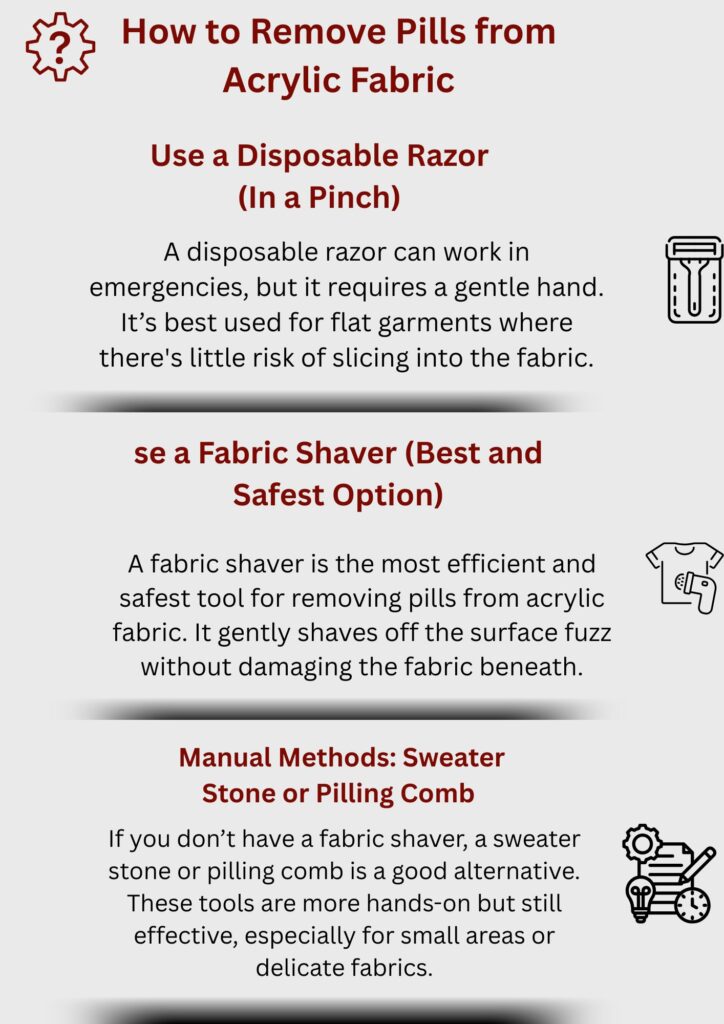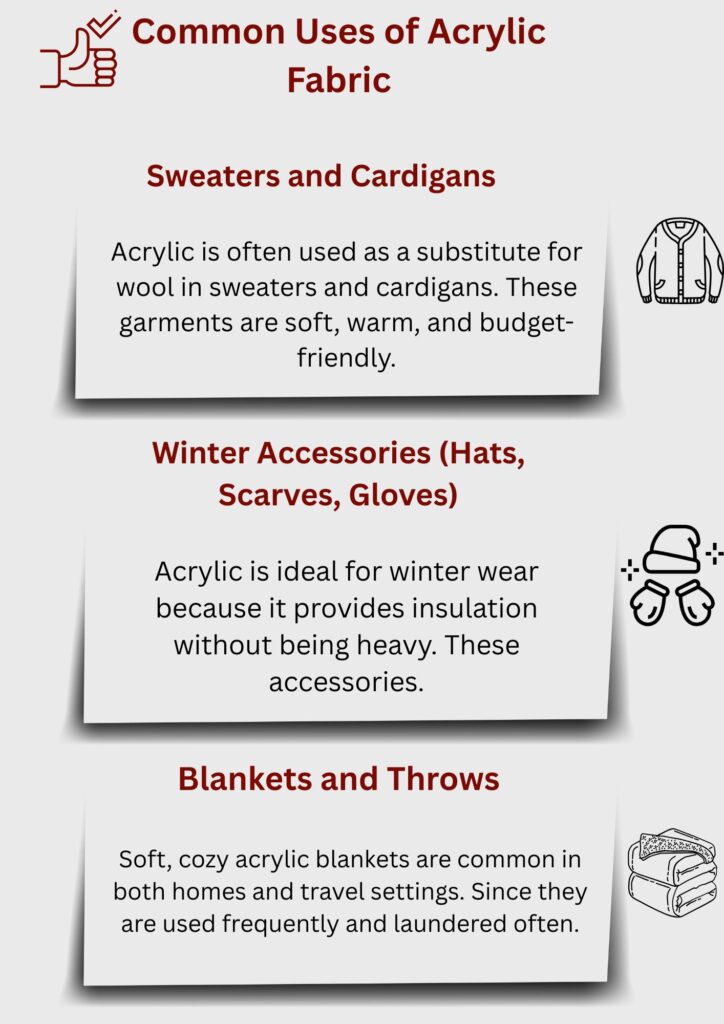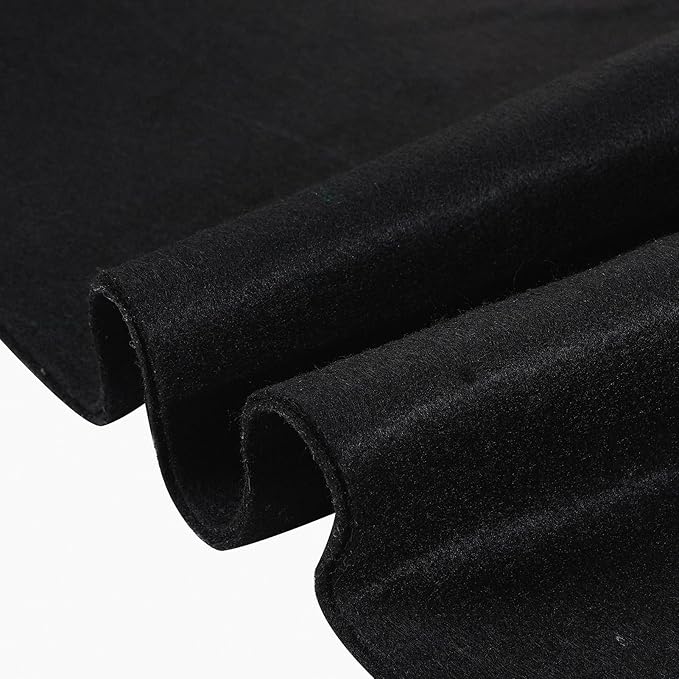Introduction
The acrylic cloth is a man made material comprising of acrylonitrile which is a petroleum based compound. It was created to imitate the softness and warmth of wool and therefore was very popular to use in creating winter clothes. The fiber is easy to carry, cheap and comes in a variety of colors and textures. Consequently, it finds wide application in clothes such as sweaters, scarves, hats, blankets, gloves and socks.
Although acrylic might appear and feel warm, there are numerous reservations that are raised by most consumers concerning its durability. The question of whether acrylic fabric pills is among the most commonly used ones. It is this particular question that is the topic of this article, and this article will focus in great detail on the question of why acrylic pills, how it compares to other fabrics, and what you can do to make your clothes last longer.
What is Pilling? The Unwanted Fabric Flaw
Pilling is a result of formation of fuzzy balls on the surface of a fabric. These small balls consist of loose fibers which get tangled with friction. Pilling commonly appears on high-friction spots, such as underarms, cuffs or the pant pant legs.
Pilling usually happens during washing, wearing, or even rubbing against seats and bags. Although it affects the look of the fabric, pilling doesn’t always mean the fabric is weak or unusable. However, heavy pilling can make clothes appear old or poorly made, even when they’re relatively new.
Why Does Pilling Occur on Fabric?
Pilling is the logical consequence of friction with time. This is more often with shorter fibers and looser weaves. The use of the name of the pills in some cases may just be cosmetic whereas in others maybe because of a substandard material.
Does Acrylic Fabric Pill? The Straight Answer
Yes, acrylic material tends to pill. This is partly as a result of its fibers being synethetic in nature as they are smooth and also are often in shorter lengths. The traits result in the fibers becoming more tangled due to friction.
How Does Acrylic Compare to Other Fabrics in Pilling?
The cotton pills less and the wrinkles more. Wool is also natural but it can pill but in some cases is more long lasting. As compared to acrylic, polyester is less prone to pilling but not as soft. Some protection against pilling can occur when using an acrylic blend at least in combination with cotton or wool.
Why Does Acrylic Pill More Than Other Fabrics?
Several factors contribute to acrylic’s high pilling rate. Firstly, synthetic fibers like acrylic have a smooth surface. This causes broken or loose fibers to slide easily and tangle on the fabric’s surface. Secondly, many acrylic fabrics use short-staple fibers. These are more likely to become dislodged and form pills than long-staple fibers.
The Role of Friction and Fiber Length
Friction from daily wear, machine washing, or even sitting down causes stress on the fibers.On the other hand, high-quality acrylic fabrics made from longer fibers may resist pilling for a longer period, but they are usually more expensive.
The fibers are stressed by friction due to everyday wear and tear, washing the clothes in a machine, or even sitting on the clothes. When the shorter fiber is used, it can be pulled out more readily and thus pilling occurs quicker. Meanwhile, better quality acrylic fabrics with longer fibers might take longer before pilling during their service but they are normally costlier.
How to Prevent Acrylic Fabric from Pilling
You can prevent pilling to an extent by taking care of what can cause pilling. Every step can last long in washing, drying, wearing, and storing by using preventive measures.
Washing Tips to Minimize Pilling
Use hand wash or lower setting: This lowers the machinery handling that leads to friction.
- Invert clothes: This will prevent the outer one from wearing.
- Apply light detergent: The tough chemicals have a tendency of wearing out the strands and will promote pilling.
- Do not wash with abrasive yarn: Denim and towels will feel like sandpaper to a soft acrylic.
Tips to Dry with Less Friction
- Air dry flat: Do not tumble dry this will make heat and movement.
- Avoid wringing and twisting: do not wring.
- Lay on a clean towel to dry: This is the way during which agitation is lowered.
Wearing & Storing Tips to Reduce Wear
- Do not use rough items: Rough back packs, seat belts and chairs are all potential sources of friction.
- Hang no: Stretching and putting strain on the fibers; Pockets bulged with stored clothes tend not to be use to their full capacity.
- Change your wear: Allow clothes some time to rest between use.
How to Remove Pills from Acrylic Fabric
Pills can form, even in spite of precautions. Fortunately, it is possible to take them off safely without damaging your clothes.

Acrylic De-Pilling Best Tools
- Fabric shaver: A gadget that does the same thing; the pill removing, but in a somewhat faster and more consistent fashion, is powered by batteries.
- Pilling comb, or sweater stone: Hand held devices that lift pills off of the material.
- Disposable razor: It will do in a pinch, but lightly and flat only.
Important Precautions
- Do not ever squeeze pills by hand: this might ruin the cloth and cause snags.
- Test instruments on a small spot at first: make sure they do not damage the texture or color.
- Take your time: Do not hurry since you can end up with torn or holey garments.
Is Acrylic a Good Fabric Despite Pilling?
Acrylic cloth does have a lot of advantages. It is soft, light weight and usually hypo-allergenic. It is also dye-fast, and that is, it remains colorful after numerous washings. Also, it is affordable, so it is a perfect choice in terms of seasonal wear.
Pros and Cons of Acrylic
- Advantages: Cheap, color-fast, soft, hypoallergenic and warm.
- Cons: It is highly prone to pill, it is not as breathable as other materials, and some users may find it to be a touch plasticky.
Despite pilling, acrylic remains popular for winter items like scarves, gloves, hats, and blankets where durability may be less of a concern.
Acrylic vs. Other Fabrics: Pilling Compara tion Guide
Knowing the comparison between acrylic and other materials will enable one to make better decisions. And this is a rapid comparison:
Cotton
- Pilling: inferior to acrylic.
- Negative: Drapes in a wrinkled and shrinking manner.
Wool
- Pilling: Pills, however, quite sturdy.
- Upside: Very classy, and is warm.
Polyester
- Pilling: Less likely in comparison to acrylic.
- Cons: Not so soft, can absorb the smell.
Blended Fabrics
- Acrylic + Wool/Cotton; blending will be able to help cut down on pilling and make the material stronger.
- Advantage: The advantage is that it is a combination of the advantages of both fibers.
Common Uses of Acrylic Fabric

Sweaters and Cardigans
Acrylic is often used as a substitute for wool in sweaters and cardigans. These garments are soft, warm, and budget-friendly, but because they’re worn frequently and rub against surfaces like bags and furniture, they tend to pill quickly.
Winter Accessories (Hats, Scarves, Gloves)
Acrylic is ideal for winter wear because it provides insulation without being heavy. These accessories, however, experience a lot of movement and rubbing—especially gloves—which can cause pilling on the surface.
Blankets and Throws
Soft, cozy acrylic blankets are common in both homes and travel settings. Since they are used frequently and laundered often, they are susceptible to pilling—especially along the edges and in high-touch zones.
Conclusion
Acrylic fabric pills, but it does not mean it is not wearable. Poor and improper care can reduce the life of your acrylic garments; however with good decisions, you can prolong its life. Select acrylic mixtures of good quality and use gentle methods of washing and minimize friction whenever you can.


